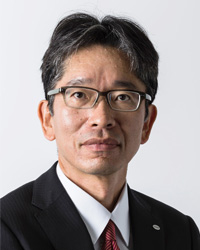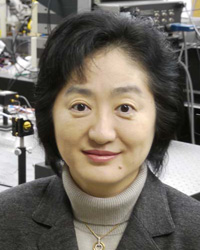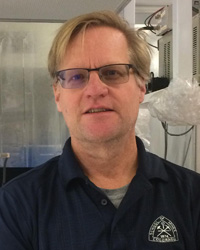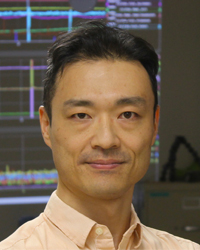
プレナリーセッション4月19日(水) 9:00-12:10 <Room 501+502>

松ケ谷 和沖
(デンソー ADAS推進部長)
“自動車安全システムにおける光技術”
One of the biggest problems with vehicles is traffic accidents. To make vehicles safer, ADAS (Advanced Driver Assistance System) and AD (Automated Driving) applications are being developed actively.
Key technologies to realize ADAS/AD, safety applications, are sensing and HMI (Human Machine Interface). Vehicle percepts its surroundings and find potential danger by utilizing sensing devices. And vehicle sends notification and warning to the driver via HMI. For the sensing and HMI devices, optical technologies play an important role.
In my presentation, firstly current development status of ADAS/AD is introduced. And then, I focus on surround sensors used for perception. Typical sensors, cameras, radar and LIDAR (Light Detection and Ranging) are introduced and their functions are explained. Next, I introduce HMI devices, DSM (Driver Status Monitor) and HUD (Head Up Display). Finally I summarize expectations about optical technologies to improve the performance of the devices explained in my talk.
Biography
Kazuoki Matsugatani received B. Eng. and M. Eng. degrees from Kyoto University in 1987 and 1989, respectively, and he joined DENSO CORPORATION in 1989. He has more than 25 years’ experience of R&D activities in electronic engineering, including semiconductor physics, microwave and millimeter-wave circuits, wireless communications and ADAS (Advanced Driver Assistance System). In 2010, he received Ph.D. from Nagoya Institute of Technology, and was appointed as Director of Corporate R&D Division 3. Then in 2015, he was moved to R&D Division 1. In 2016, when ADAS Business and Technology Development Division was established at DENSO, he was assigned as Director and has been vigorously promoting ADAS and AD (Automated Driving) development.

美濃島 薫
(電気通信大学教授、JST)
“超精密光ファイバによる周波数コムとその計測応用”
Optical frequency combs have opened up several new application fields not only in frequency metrology as “ultraprecise frequency ruler” but also in broad area by use of its capability for fully controlling the phase, time, and frequency information of light waves, i.e., “optical synthesizer”, with an extreme precision and wide dynamic range. In this talk, development of fiber-based frequency combs, which are the key for practical application is presented. Moreover, some of the applications of frequency combs, including precision spectroscopy for material characterization and three-dimensional imaging are presented.
Biography
Kaoru Minoshima is a Professor at the University of Electro-Communications (UEC), and the Research Director of JST, ERATO MINOSHIMA Intelligent Optical Synthesizer Project (IOS) since 2013. After receiving Ph.D. degrees from the University of Tokyo (1993), she has been with the National Institute of Advanced Industrial Science and Technology, and also worked at the University of Bordeaux I, the Massachusetts Institute of Technology, and a guest professor at the Tokyo University of Science.
Her areas of research are ultrafast optical science and technology, frequency combs, and optical metrology.
She received various prizes including the Prize for Science and Technology by MEXT, Japan (2008). She served as several international committees including the General Co-Chair of CLEO:2011, and is a member of the Science Council of Japan and a Fellow of OSA and JSAP.

Jeff Squier
(米国 コロラドスクールオブマインズ 教授)
“限界を超える:イメージングと生物学的システム操作の時空間技術を中心にして”
Imaging and manipulating biological systems with optical sources is desirable from the perspective of providing selective, noninvasive methods that enable quantitative assessment and the ability to potentially alter the system of interest with minimal perturbation. There are inherent challenges to optical tools that can achieve optimal application given the constraints of the biological system: scattering, tissue differences, time scales of the event relative to the procedure being performed, to name a few. Significantly, the ultrafast optical community has made tremendous strides in advancing the application of femtosecond laser sources to meet these challenges. Here, we will show how large focal volumes which translates to large working distances, convenient for biology, can lead to gains in both imaging and manipulation without sacrificing resolution, and can be made compatible with scattering media. This is achieved through careful simultaneous spatial and temporal control of the focal volume (four-dimensional focusing) and spatial amplitude and/or phase modulation of the excitation source. Significantly, these methods that enable enhanced resolution past classical limits are straightforward to implement. Indeed, pragmatic application of these methods is an important consideration and will be presented.
Biography
Jeff Squier received his BS degree in Engineering Physics, and MS in Applied Physics from the Colorado School of Mines. He received his PhD from the University of Rochester, Institute of Optics. He is presently Department Head of Physics, Colorado School of Mines, and maintains an active research group in ultrafast optics mainly focusing on nonlinear microscopy and machining and manipulating materials with femtosecond laser pulses. He is a Fellow of the Optical Society of America and a past recipient of the SPIE Harold Edgerton award.

新井宏二
(Caltech, LIGO Senior Scientist)
“Gravitational Wave Detection: Laser Interferometer Technologies in Advanced LIGO”
On September 14, 2015, the two detectors of the Laser Interferometer Gravitational-Wave Observatory (LIGO) simultaneously observed a transient gravitational-wave (GW) signal. The waveform analysis indicated that the source was an inspiral and merger of two binary black holes at 1.3 billion light years from the earth. This was the first direct detection of GWs and the first observation of binary black hole merger. LIGO detected another binary black hole merger in December 2015.
Here, GW detection using high precision laser interferometry is reviewed. Technological approaches in the current LIGO detectors will be introduced, as well as challenges for the future generation detectors.
Biography
Koji Arai joined the LIGO Laboratory at Caltech in 2009 as Senior Research Fellow. Koji has been a Senior Scientist with the LIGO Laboratory at Caltech since 2016, after serving as Research Assistant Professor in 2015. His research area is control systems and noise reduction for precision laser interferometry. Before moving to Caltech, he was Research Associate and Assistant Professor at National Astronomical Observatory of Japan between 1999 and 2009 where he worked on the Japanese laser interferometer gravitational wave project TAMA300. He received his Ph.D. in Physics from the University of Tokyo in 2002.











